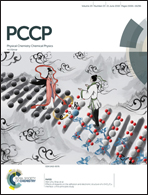Intrinsic charge-mobility in benzothieno[3,2-b][1]benzothiophene (BTBT) organic semiconductors is enhanced with long alkyl side-chains
Abstract
Recent measurements show that organic materials with a conjugated benzothieno-benzothiophene (BTBT) core exhibit unprecedented charge-carrier mobilities, dramatically influenced by the size of the side-chains. Using a multitude of computational tools, we, in depth, calculate the molecular ordering and charge-transport of these materials to rationalize the side-chain dependence. The reported experimental hole mobilities typically fall within the range of 1–100 cm2 V−1 s−1, therefore we employ both band transport models using deformation-potential theory based on DFT-D3 methodology and hopping transport using kinetic Monte Carlo simulations employing Marcus–Levich–Jortner charge-transfer theory. Band transport calculations are performed in a perfect lattice, considered as a structurally ordered morphology, while hopping transport calculations are performed for both ordered and disordered morphologies based on molecular dynamics simulations. We find that intrinsic mobility in BTBTs is critically controlled by the alkyl chain length; typically, longer alkyl side-chains regulate intrinsic disorder, cause improved balance between different transport directions and, ultimately, lead to enhanced charge-carrier mobility.
![Graphical abstract: Intrinsic charge-mobility in benzothieno[3,2-b][1]benzothiophene (BTBT) organic semiconductors is enhanced with long alkyl side-chains](/en/Image/Get?imageInfo.ImageType=GA&imageInfo.ImageIdentifier.ManuscriptID=C8CP01640B&imageInfo.ImageIdentifier.Year=2018)


 Please wait while we load your content...
Please wait while we load your content...